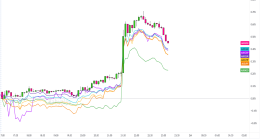Panasonic first announced its Lumix S1 and S1R full-frame mirrorless cameras last year, but now the company is sharing the full details of two products it hopes will be recognized for their photo chops just as much as for Panasonic’s well-known video strengths. The formula is something we’ve seen from both Sony and more recently Canon: one of them is a high-megapixel resolution beast that’s aimed at pro-level photographers — the 47.3MP S1R in this case — and the other is a more well-rounded camera for a wider audience of hybrid shooters. That’s the 24.2MP S1, which will retail for $2,499 (body only) or $3,399 with a 24-105mm lens. The S1R body costs $3,699 or $4,599 with the same lens.
Both use the L-Mount, a system owned by Leica with Panasonic and Sigma as licensees and members of the L-Mount Alliance. To start, Panasonic is releasing three launch lenses:
- 50mm f/1.4 S Pro for $2,299. This is the lens that Panasonic says delivers its highest-quality optical performance of the bunch and is best in sharpness, bokeh, contrast, etc.
- 70-200mm f/4 S Pro for $1,699
- 24-105mm f/4 Macro for $1,299. This is the kit lens that will be offered alongside both the S1 and S1R. It’s not part of the S Pro series, but it does have the unique ability to take macro shots from just under a foot away without having to toggle a focus switch.
Panasonic is planning to release three additional lenses by the end of 2019, and you’ll also have options from Leica and Sigma to choose from. Note that Panasonic’s own lenses no longer carry Leica branding, but the S Pro lenses are “certified by Leica” to signify quality.
:no_upscale()/cdn.vox-cdn.com/uploads/chorus_asset/file/13728926/cwelch_190123_3204_0001.jpg)
When you pick them up, you’ll notice that these cameras are heavy. Both the S1 and S1R weigh 2.25 pounds with a battery and XQD card inside (or 2.24 if you’re using SD). For comparison’s sake, that’s a hair more than Nikon’s D850 professional DSLR. Panasonic says the in-body stabilization is where some of that heft comes from; the company says it’s built with high performance and longevity in mind. Even so, the S series cameras are substantially heavier than the Nikon Z and Canon EOS R, and you can feel the difference.
Panasonic claims it has pored over every detail for the new S cameras, from the material used on the grip to button placement and customizability. Both cameras have a gorgeous 5.76 million-dot OLED electronic viewfinder that can be switched between 60fps and 120fps refresh rate. The back joystick has been upgraded to support 8-way presses (it now works diagonally), and there’s a status LCD at the top that Panasonic has brought over from the G9.
:no_upscale()/cdn.vox-cdn.com/uploads/chorus_asset/file/13728939/cwelch_190123_3204_0006.jpg)
The rear buttons are illuminated, which is something both Canon and Nikon whiffed on. And there are two card storage slots! You get both an UHS-II SD slot and a XQD slot. Also, Panasonic gave the lock function a dedicated switch at the top left on the back, so you can quickly lock the touchscreen, d-pad, joystick, dials, etc. without having any settings change if someone wants to try your camera.
:no_upscale()/cdn.vox-cdn.com/uploads/chorus_asset/file/13728932/cwelch_190123_3204_0013.jpg)
The S1R is being aimed at photographers first and foremost. It’s for pros taking landscapes and other shots where every bit of detail counts. Panasonic’s pricier S series has a native ISO range of 100 to 25,600. And if 47.3 megapixels somehow aren’t enough for you, you can enable the camera’s high-res mode to get a gigantic 187MP RAW file. That comes out to a resolution of 16,736 x 11,168 pixels. As with the G9, Panasonic accomplishes this hi-res mode by shifting the sensor eight times by half a pixel to create a 4x resolution increase. For video, the S1R can record up to 4K at 60p, but it captures that video at a crop and uses pixel binning to ease stress on the processor from all those pixels.
:no_upscale()/cdn.vox-cdn.com/uploads/chorus_asset/file/13728944/cwelch_190123_3204_0010.jpg)
The S1 is definitely more suited for videographers. It records 4K with full-sensor readout and no crop to speak of, and there’s no recording time limit for 4K at 30 or 24p. (4K at 60fps is time-limited on both the S1 and S1R to 30 minutes on the former and 15 with the latter.) Native ISO runs from 100 to 51,200, and the S1’s high-res mode is good for 96MP shots. But Panasonic has decided to charge extra for some of the S1’s most powerful video capabilities.
Eventually, the S1 will support 4:2:2 10-bit 4K/30p internal recording and 4:2:2 10-bit 4K/60p external — but not at launch. When Panasonic does release those features, users will have to pay an additional fee on top of the camera’s initial cost to access them. Same goes for V-Log, which is also absent from the S1 when it ships. (These options won’t be available on the S1R period.)
But let’s get back to what both cameras share:
The in-body stabilization on the S1 and S1R is good for 6 stops of shake reduction when used with an IS lens or 5.5 stops with lenses that lack stabilization, according to Panasonic. Each can shoot down to -6EV in low light or -3EV in low light and low contrast scenes (if you’re using an f/1.4 lens like Panasonic).
:no_upscale()/cdn.vox-cdn.com/uploads/chorus_asset/file/13728942/cwelch_190123_3204_0017.jpg)
Some might be disappointed by a lack of phase-detect AF, but Panasonic claims its contrast AF with DFD technology can outperform on-sensor phase detect systems without any of the potential drawbacks such as horizontal banding when shadows are raised. And if there are areas where it can’t, Panasonic says It can improve accuracy through updates and teaching its “deep learning AI” new things. As is, Panasonic touts a .08-second lock-on for single AF.
The S1 and S1R can identify human bodies and animals (including birds, cats, dogs, and others) for subject tracking. The AI-assisted autofocus system can also lock in on human eyes, but not those belonging to your pets.
Other similarities include:
- Burst: 6FPS in continuous autofocus, 9FPS in single-focus
- 3.2-inch tilting touchscreen (2.1 million dots)
- Shutter rated for 400K actuations
- USB-C 3.1 Gen 1 PD (can plug into external PD battery pack while shooting)
:no_upscale()/cdn.vox-cdn.com/uploads/chorus_asset/file/13728935/cwelch_190123_3204_0007.jpg)
This article is from The Verge








